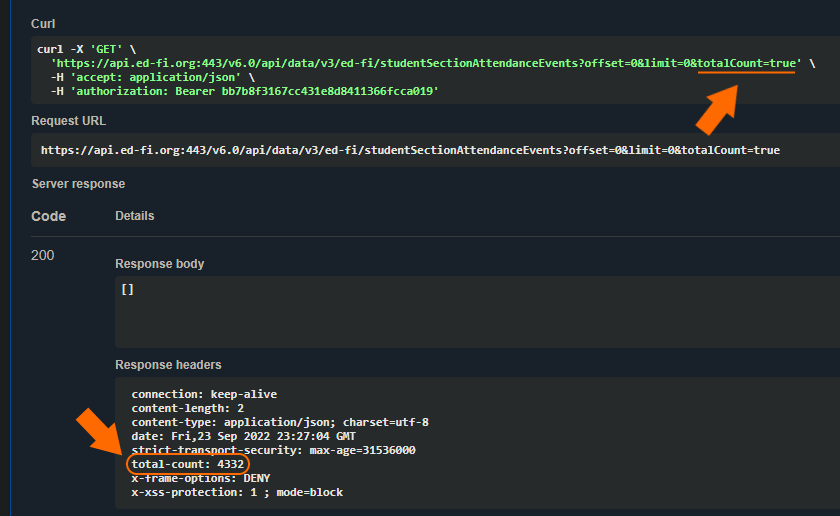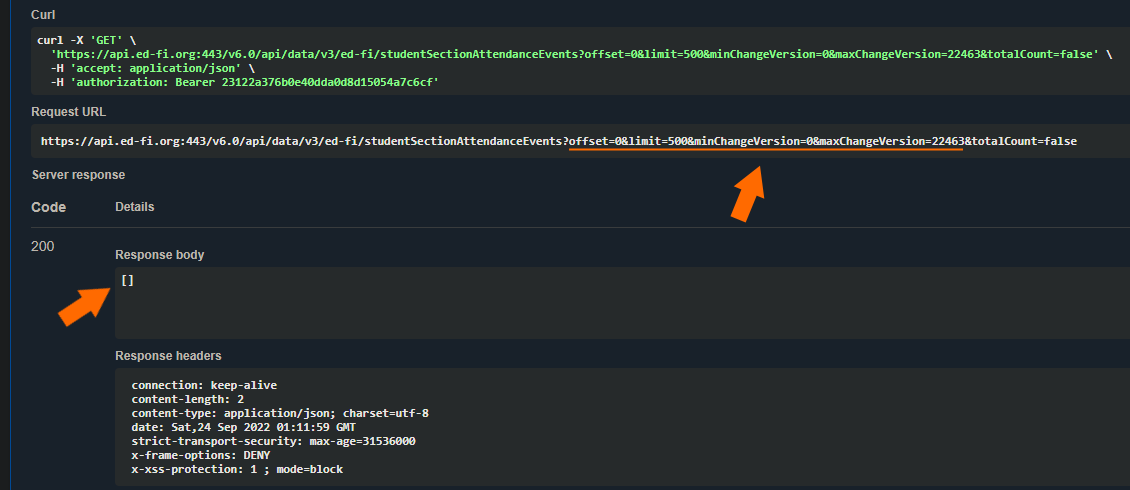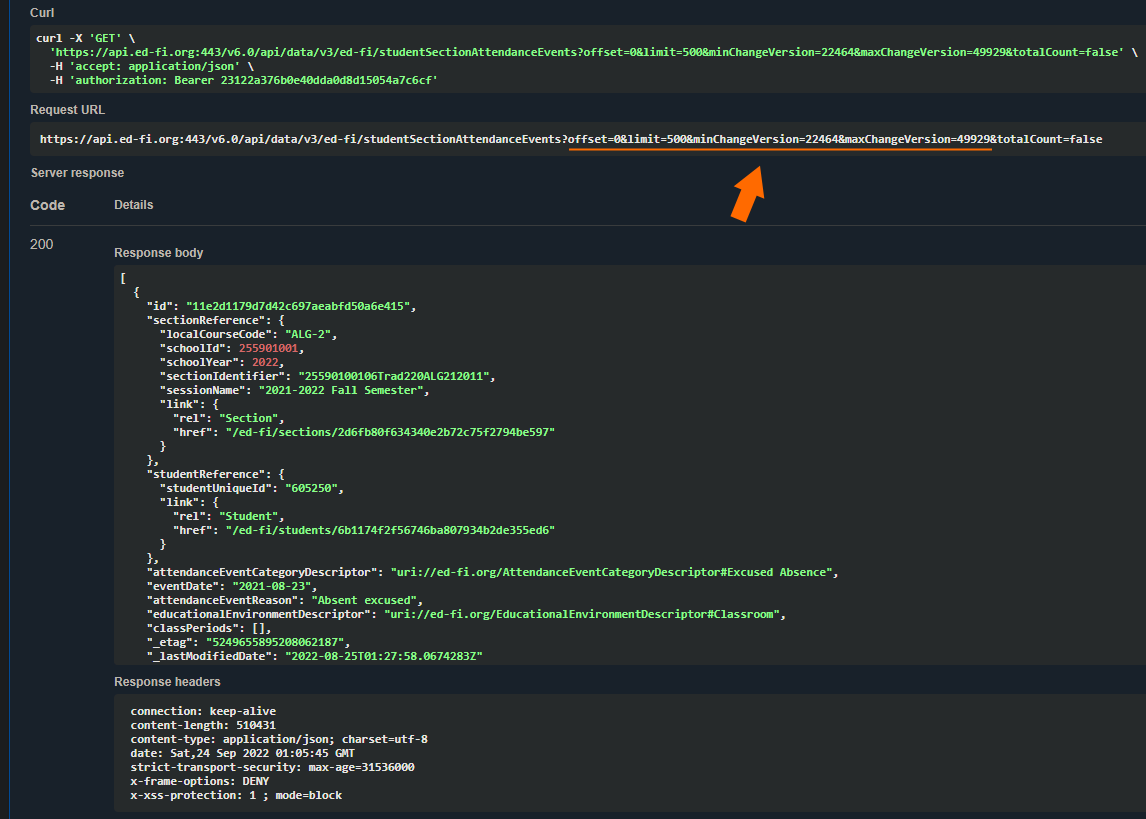A newer version of the Ed-Fi ODS / API is now available. See the Ed-Fi Technology Version Index for a link to the latest version.
Improve Paging Performance on Large API Resources
Introduction
The Ed-Fi ODS API uses Offset Paging (through the offset and limit query string parameters on API requests). However, this approach is known to suffer from increasingly poor database performance as the underlying data set gets larger. This article describes a mechanism you can use through the API to engage a technique known as "Keyset Paging" to improve the execution plan used by the database during paging. While this may not be the most optimal solution for all implementations, it may provide improved API paging performance on large datasets by utilizing artifacts from existing change query feature.
Standard API Paging (Offset Paging)
When retrieving all the data from an API resource, API clients will issue a series of paged requests (using Offset Paging via the offset and limit parameters) that look something like the following:
GET /ed-fi/studentSectionAttendanceEvents?offset=0&limit=500
GET /ed-fi/studentSectionAttendanceEvents?offset=500&limit=500
GET /ed-fi/studentSectionAttendanceEvents?offset=1000&limit=500
- ...
On large data sets, you may notice increasing levels of performance degradation as the page requests get deeper due to the growing number of reads being performed by the database engine with each successive request.
Keyset Paging using Change Queries
While you're most likely not using Change Queries for processing changes when you start to see the paging-related performance degradation, you can actually use the features of the Change Queries API to engage Keyset Paging in the underlying database queries.
Keyset Paging works by applying range-based criteria for column(s) with unique values that are also backed by an index. This enables the query optimizer to limit the amount of data being processed with the request using an index seek, and therefore limit the number of rows that are read. Fortunately, the Change Queries API feature adds the ChangeVersion column along with an index to every resource's underlying ODS table, which happens to fit the requirements for using Keyset Paging. However, while ChangeVersion column is suitable for Keyset paging, it is not the best candidate. The Change Version values are determined by a global shared sequence, and thus the value increases with every change made in the ODS. Also the distribution of records in a given table across an arbitrarily chosen range of Change Version values is not likely to be uniform.
The following steps illustrate how to use Change Queries API to engage Keyset Paging. Since this example uses sample dataset that is bulk loaded loaded in resource dependency order, the records in each table are clustered closely together (in terms of their Change Version values against the whole range of possible values). Due to the pattern of data load utilized, this example is not depicting most optimal Keyset paging but can be used to understand the mechanism involved.
Step 1 - Obtain the maximum available change version
To identify the possible range values for your partitions, you must first obtain the newest change version value from your source API by sending a GET request to the availableChangeVersions resource:

Step 2 - Obtain the total count of items in the resource
Send a request to the resource with the totalCount=true query string parameter and get the total item count from the Total-Count response header.

Step 3 - Define the partitions as ranges of Change Version values
Decide what your ideal partition size is for your needs. The API will be performing Offset Paging within each partition, so they shouldn't be too big or too small. For example, if you are processing a resource with 2 million items, you might target a partition size of 50,000 items. That way, instead of attempting to process all the data at once, you're processing about 40 smaller partitions of data and the paging performance within each of the smaller partitions will be greatly improved.
Use the following formula to determine the number of partitions:
# of partitions = item count / partition size
Next, use the following formula to determine the size of the ranges (expressed in the Change Version values):
range size = max change version / # of partitions
For the purpose of this example, we'll target a partition size of 1,000 against 4,332 total items.
4332 / 1000 = 4.332 partitions
Rounding up to 5 partitions, we'll now need to divide the available Change Version values accordingly to get the approximate range size:
112317 / 5 = 22463.4
Thus, our partitions will be defined based on Change Versions roughly as follows:
| Partition | minChangeVersion | maxChangeVersion |
|---|---|---|
| 1 | 0 | 22464 |
| 2 | 22465 | 49929 |
| 3 | 49930 | 67393 |
| 4 | 67394 | 89857 |
| 5 | 89858 |
The range criteria for each partition can be added to the queries using the minChangeVersion and/or maxChangeVersion query string parameters.
Step 4 - Issue paged requests to retrieve all data from each partition
For each partition, send requests with the appropriate minChangeVersion and/or maxChangeVerion parameters, along with the Offset Paging parameters of limit and offset until all data in each partition has been retrieved.
On the populated sample ODS, the Change Version value ranges defined above for partitions 1, 3, 4 and 5 actually return no items.

This is because the effectiveness of the technique is greatly influenced by the pattern of loading and/or usage by API clients on the underlying ODS. In this case, the populated sample database is loaded en-masse in resource dependency order, and thus the records in the StudentSectionAttendanceEvent table are not well distributed across the partition ranges we've calculated (they're clustered together with Change Version values that place them all in partition 2, as we've defined them).
The following image shows that data is returned for the first page of the second partition:

So for this example, the following requests would be sent to the API:
| Partition 1 (0 items) |
|---|
GET /ed-fi/studentSectionAttendanceEvents?offset=0&limit=500&maxChangeVersion=22464 |
| Partition 2 (4,332 items) |
|---|
GET /ed-fi/studentSectionAttendanceEvents?offset=0&limit=500&minChangeVersion=22465&maxChangeVersion=49929 |
GET /ed-fi/studentSectionAttendanceEvents?offset=500&limit=500&minChangeVersion=22465&maxChangeVersion=49929 |
GET /ed-fi/studentSectionAttendanceEvents?offset=1000&limit=500&minChangeVersion=22465&maxChangeVersion=49929 |
GET /ed-fi/studentSectionAttendanceEvents?offset=1500&limit=500&minChangeVersion=22465&maxChangeVersion=49929 |
GET /ed-fi/studentSectionAttendanceEvents?offset=2000&limit=500&minChangeVersion=22465&maxChangeVersion=49929 |
GET /ed-fi/studentSectionAttendanceEvents?offset=2500&limit=500&minChangeVersion=22465&maxChangeVersion=49929 |
GET /ed-fi/studentSectionAttendanceEvents?offset=3000&limit=500&minChangeVersion=22465&maxChangeVersion=49929 |
GET /ed-fi/studentSectionAttendanceEvents?offset=3500&limit=500&minChangeVersion=22465&maxChangeVersion=49929 |
GET /ed-fi/studentSectionAttendanceEvents?offset=4000&limit=500&minChangeVersion=22465&maxChangeVersion=49929 |
| Partition 3 (0 items) |
|---|
GET /ed-fi/studentSectionAttendanceEvents?offset=0&limit=500&minChangeVersion=49930&maxChangeVersion=67393 |
| Partition 4 (0 items) |
|---|
GET /ed-fi/studentSectionAttendanceEvents?offset=0&limit=500&minChangeVersion=67394&maxChangeVersion=89857 |
| Partition 5 (0 items) |
|---|
GET /ed-fi/studentSectionAttendanceEvents?offset=0&limit=500&minChangeVersion=89858 |
Conclusion
The use of Change Queries features to engage Keyset Paging approach at the database-level may provide an improvement in paging performance on large data sets, but the effectiveness of this approach can be influenced by the usage patterns of the Ed-Fi ODS API by API clients.